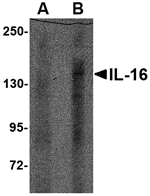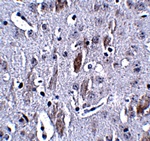IL-16 was initially identified as a chemotactic cytokine, but is now known to possess a wide range of activities. Later studies have more fully characterized IL-16 as an immunomodulatory cytokine that contributes to the regulatory process of CD4+ T cell recruitment and activation at sites of inflammation in association with asthma and several autoimmune diseases. The precursor of IL-16 (pro-IL-16) is thought to be cleaved towards the C-terminal region by Caspase-3, releasing a 20 kDa active form that binds to and signals through CD4. Besides acting as a chemotactic cytokine, IL-16 is thought to also be involved in the regulation of T cell proliferation and multiple infectious, immune-mediated, and autoimmune inflammatory disorders including irritable bowel syndrome, systemic lupus erythematosus, and neurodegenerative disorders. At least two isoforms of IL-16 are known to exist; the longer isoform (also known as NIL-16) is detected only in neurons of the cerebellum and hippocampus.



